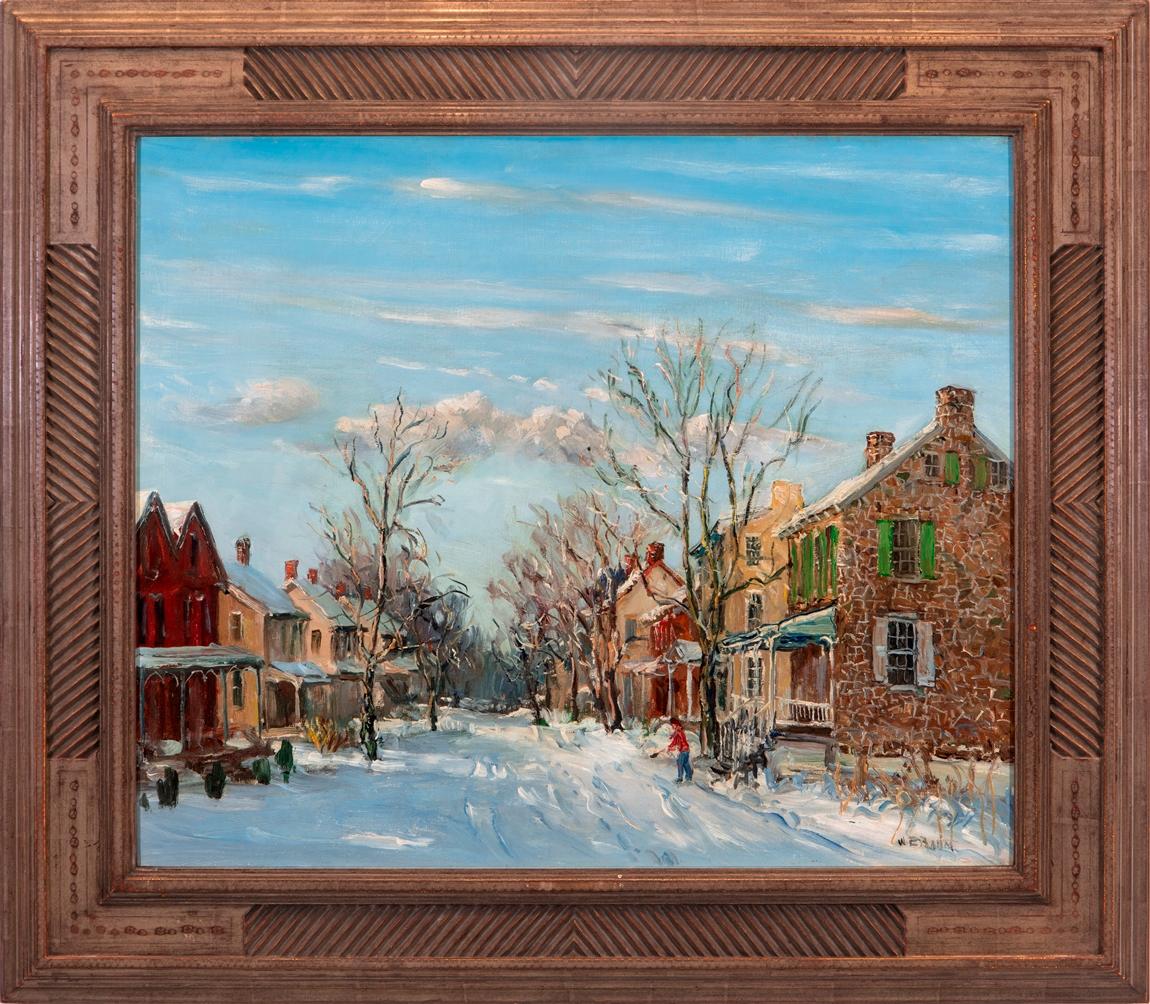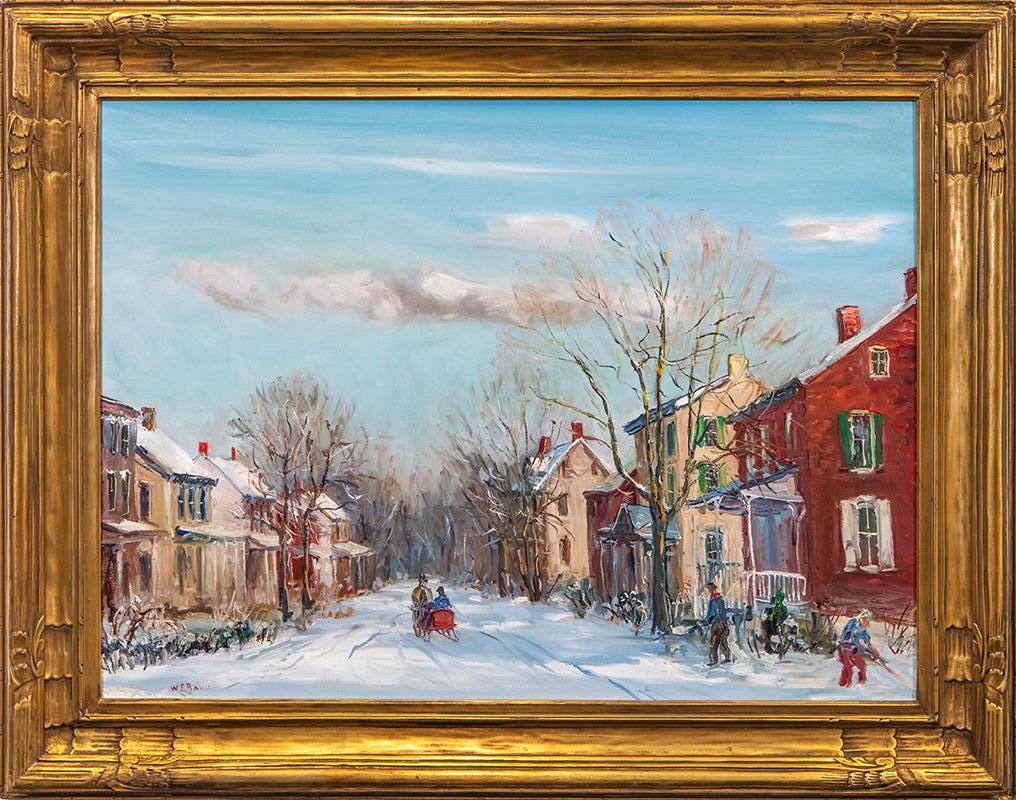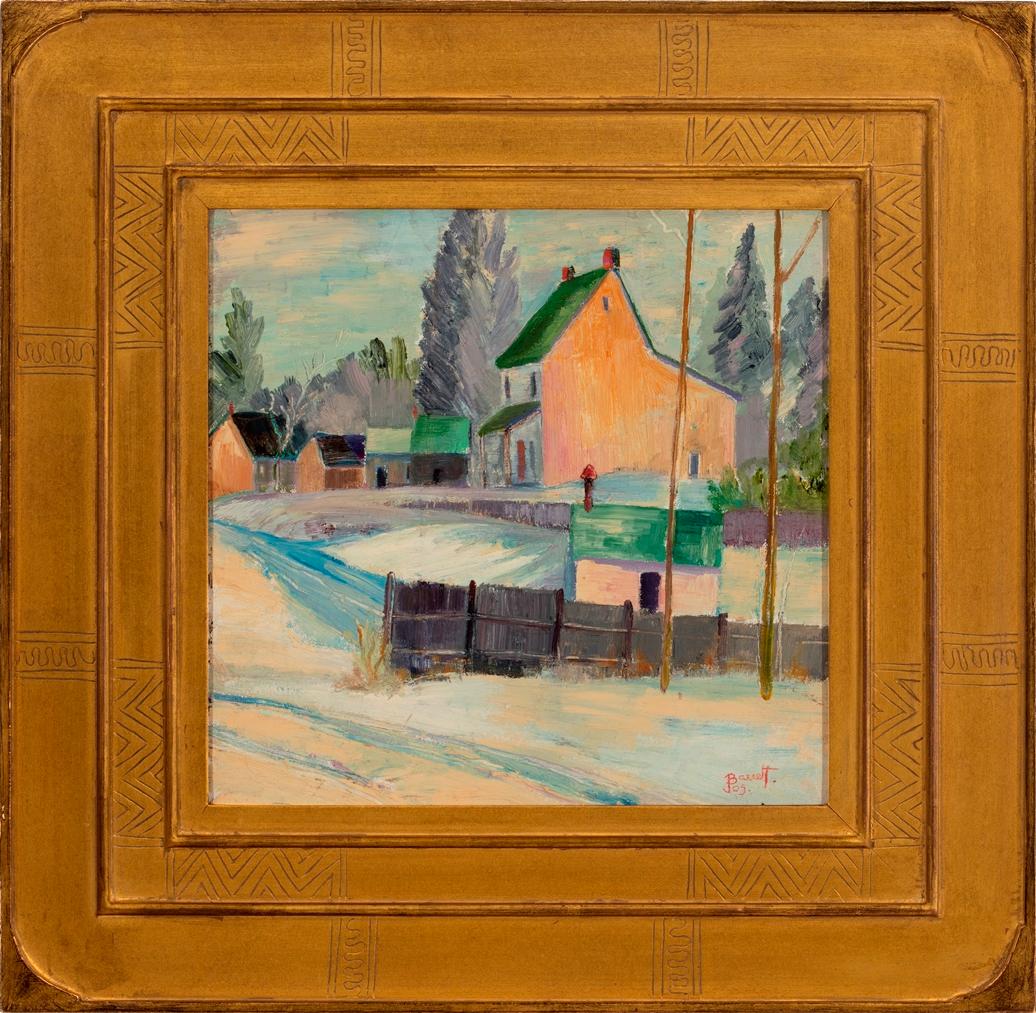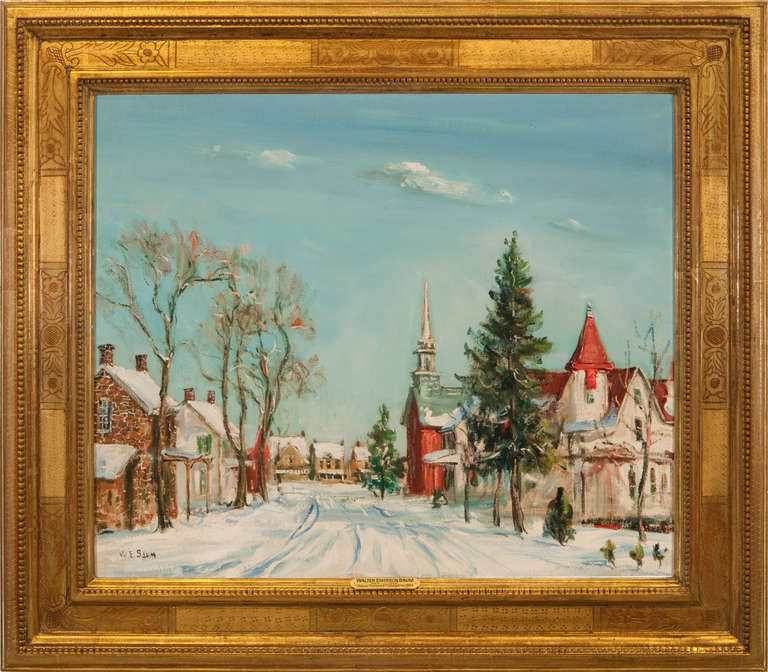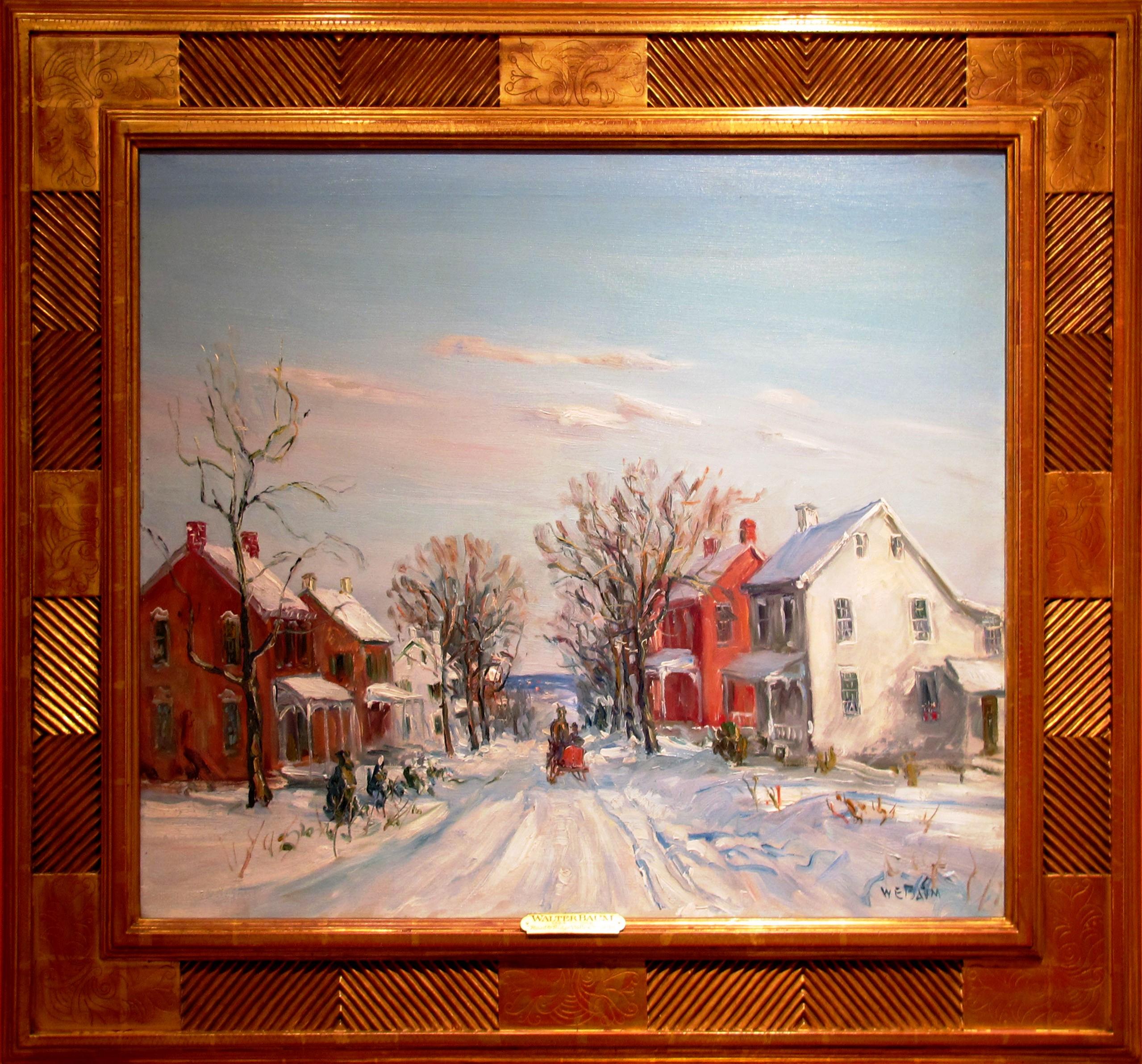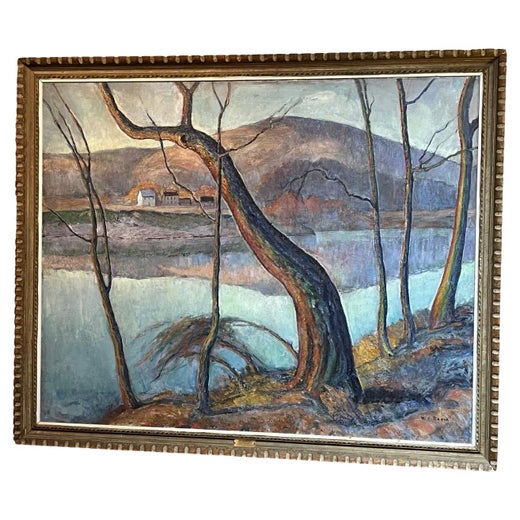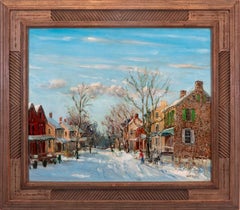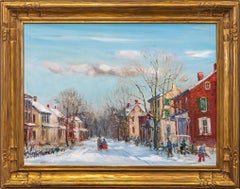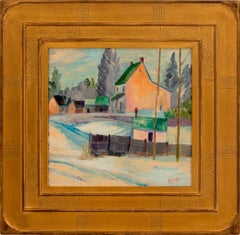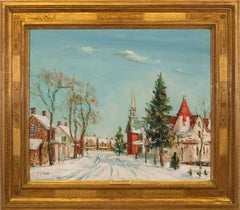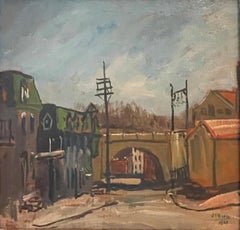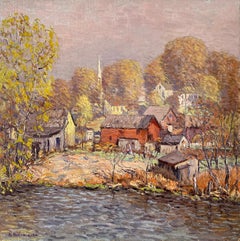Items Similar to "Lehigh County Village"
Want more images or videos?
Request additional images or videos from the seller
1 of 6
Walter Emerson Baum"Lehigh County Village"Circa 1935
Circa 1935
$74,375
£56,784.98
€65,614.54
CA$104,408.42
A$116,374.06
CHF 61,057.48
MX$1,421,117.04
NOK 773,120.43
SEK 730,716.40
DKK 489,709.89
About the Item
Jim’s of Lambertville is proud to offer this artwork by:
Walter Emerson Baum (1884 - 1956)
Born in Sellersville, Pennsylvania, Walter Baum was one of the only members of the New Hope Art Colony actually born in Bucks County. Greatly inspired by the painters of the original “New Hope School”, Baum had an extremely profound impact on artistic development throughout the Delaware Valley.
As an artist, there was no other to even come close in matching his highly prolific artistic production. His works were admired by both collectors and aspiring artists. His involvement in establishing an art school and museum in Allentown would have an enormous influence on what would become one of the largest artistic communities in the United States.
It was not until the age of twenty that Baum would begin his art studies first privately with William Trego, a respected local painter, followed by his enrollment to the Pennsylvania Academy of the Fine Arts, where his instructors included Thomas Anshutz and Daniel Garber. He was awarded the Jennie Sesnan Gold Medal from the Pennsylvania Academy in 1925.
Baum taught summer classes for the public schools of Allentown in 1926. The immense popularity of these classes would eventually lead to Baum co-founding the Kline-Baum School of Art in 1929 (later renamed the Baum School of Art). Baum also helped found the Allentown Art Museum in 1936, the Lehigh Art Alliance and the Circulating Picture Club. Baum wrote over five hundred reviews for the Philadelphia Bulletin as wells as Two Hundred Years, a study of the Pennsylvania Germans and their heritage. Baum did much to enrich the cultural environments of eastern Pennsylvania’s past. He received an honorary Doctorate of Humane Letters from Lehigh University in 1946.
During his long career, Baum worked in several mediums and painted in various styles. Many of his earlier works are magnificent impressionist landscapes of Bucks County and the Lehigh Valley showing the strong influence of Redfield and Schofield. Baum developed friendships with Schofield and Garber which deepened his appreciation for the regional landscape. In the late 1940s into 1950s, Baum’s style of painting changed completely, taking on modernist qualities similar to that of the French Post-Impressionist painters. These later works usually depict urban views of Allentown, Bethlehem and Easton as well as figurative works, still lifes and scenes portraying the students in his art classes and studio. Baum actively taught art and promoted artists throughout his life. As art editor of the Pennsylvania Bulletin, he wrote hundreds of reviews.
While he is known for his larger works, Baum painted over a thousand pictures of smaller sizes including extremely detailed 4 x 6-inch miniature landscapes. He would often paint the same scene again and again. Because of his unusually strong work ethic, not all of his many paintings are representative of his potential greatness. When studying his work, it is not uncommon to see several similar views of fair quality and then come upon a fine execution of the same scene. Great painters did not always paint great paintings, and when one was as prolific as Baum, this should be remembered and understood. There has always been a cloud cast upon Baum’s work by less knowledgeable collectors regarding forgeries and paintings finished and signed by the artist’s son. Granted, there are a lot of fake paintings bearing his name, but whether or not his son painted or signed them remains to be seen, but if a painting even looks remotely questionable, it is likely to be at best, of poor quality, and worst case a fake. Either or, this is not the kind of painting a collector should consider buying at any price. A Baum painting of investment quality will look like a fine painting and will not cast any doubt upon the trained eye.
Source: New Hope for American Art, James M. Alterman
- Creator:Walter Emerson Baum (1884-1956, American)
- Creation Year:Circa 1935
- Dimensions:Height: 31 in (78.74 cm)Width: 36 in (91.44 cm)Depth: 3 in (7.62 cm)
- Medium:
- Movement & Style:
- Period:
- Condition:
- Gallery Location:Lambertville, NJ
- Reference Number:Seller: LAM00691stDibs: LU3744755702
Walter Emerson Baum
Born of Pennsylvania Dutch extraction on December 14, 1884, Walter Baum painted among the villages and cities of these people. A pupil of W. T. Trego and the Pennsylvania Academy of the Fine Arts, he was a member of many organizations, including the Philadelphia Art Alliance, the Philadelphia Sketch Club, the Germantown Art League, the Fellowship of the Pennsylvania Academy of the Fine Arts, the Philadelphia Watercolor Club, Associate of the National Academy of Design in New York, the Salmagundi Club, the Woodmere Art League, and many others. Baum was the art editor of the Philadelphia Evening Bulletin, editor of the Sellersville Herald, a contributing artist of the Curtis Publishing Company, an illustrator for Story Classics, director of the Allentown Museum and head of Kline-Baum Art School in Allentown, PA. He was also a member of the New Hope Art Associates. The artist was a recipient of many awards, including the bronze medal from the American Artists' Exhibition in Philadelphia; the Jennie Sesnan Gold Medal from the Pennsylvania Academy; the Zabriskie Prize from the American Watercolor Society; and the Purchase Prize from the Buck Hill Art Association. He exhibited at the Pennsylvania Academy Annual Oil and Watercolor Exhibition; the Corcoran Art Gallery Biennial, Washington, D.C.; the National Academy of Design, New York; the Chicago Art Institute; and at many others throughout the country. Baum's paintings are represented in many private and permanent collections, including the Philadelphia Museum of Art, Toledo Art Museum, National Academy of Design, and the collection of the late President Franklin Delano Roosevelt. Walter Emerson Baum died in 1956.
About the Seller
5.0
Vetted Professional Seller
Every seller passes strict standards for authenticity and reliability
Established in 1997
1stDibs seller since 2014
38 sales on 1stDibs
- ShippingRetrieving quote...Shipping from: Lambertville, NJ
- Return Policy
Authenticity Guarantee
In the unlikely event there’s an issue with an item’s authenticity, contact us within 1 year for a full refund. DetailsMoney-Back Guarantee
If your item is not as described, is damaged in transit, or does not arrive, contact us within 7 days for a full refund. Details24-Hour Cancellation
You have a 24-hour grace period in which to reconsider your purchase, with no questions asked.Vetted Professional Sellers
Our world-class sellers must adhere to strict standards for service and quality, maintaining the integrity of our listings.Price-Match Guarantee
If you find that a seller listed the same item for a lower price elsewhere, we’ll match it.Trusted Global Delivery
Our best-in-class carrier network provides specialized shipping options worldwide, including custom delivery.More From This Seller
View All"Pennsylvania Dutch Village"
By Walter Emerson Baum
Located in Lambertville, NJ
Jim’s of Lambertville is proud to offer this artwork by:
Walter Emerson Baum (1884 - 1956)
Born in Sellersville, Pennsylvania, Walter Baum was one of the only members of the New Ho...
Category
1930s American Impressionist Landscape Paintings
Materials
Canvas, Oil
"Christmas Time, Sellersville"
By Walter Emerson Baum
Located in Lambertville, NJ
Jim’s of Lambertville Fine Art Gallery is proud to present this piece by Walter Emerson Baum (1884 - 1956).
Born in Sellersville, Pennsylvania, Walter Baum was one of the only membe...
Category
1930s American Impressionist Landscape Paintings
Materials
Canvas, Oil
"Bucks County Village"
By Joseph Barrett
Located in Lambertville, NJ
Illustrated in "Joseph Barrett, The Prime Years 1970s - 1990s", pg. 64, plate #074.
Category
Late 20th Century American Impressionist Landscape Paintings
Materials
Oil, Board
"Snow Covered Village"
By Walter Emerson Baum
Located in Lambertville, NJ
Jim’s of Lambertville is proud to offer this artwork.
Signed lower left. Complemented by a hand carved and gilt frame.
Walter Emerson Baum (1884 - 1956)
Born in Sellersville, Pe...
Category
1930s American Impressionist Landscape Paintings
Materials
Canvas, Oil
"Road to Ridge Valley"
By Walter Emerson Baum
Located in Lambertville, NJ
Jim’s of Lambertville is proud to offer this artwork by:
Walter Emerson Baum (1884 - 1956)
Born in Sellersville, Pennsylvania, Walter Baum was one of the only members of the New Ho...
Category
1930s American Impressionist Landscape Paintings
Materials
Canvas, Oil
"Winter Near the Creek"
By Walter Emerson Baum
Located in Lambertville, NJ
Jim’s of Lambertville is proud to offer this artwork.
Signed lower left.
Complemented by a hand carved and gilt frame.
Walter Emerson Baum (1884 - 1956)
Born in Sellersville, Pe...
Category
20th Century American Impressionist Landscape Paintings
Materials
Canvas, Oil
You May Also Like
Bucks County Winter Landscape
By Paul Bernard King
Located in Milford, NH
A wonderful winter village landscape in Bucks County by painted by American artist Paul Bernard King (1867-1947). King was born in Buffalo, New York, and ...
Category
Early 20th Century American Impressionist Landscape Paintings
Materials
Canvas, Oil
"Manayunk" Walter Emerson Baum, Pennsylvania Impressionist Landscape of Manayunk
By Walter Emerson Baum
Located in New York, NY
Walter Emerson Baum
Manayunk, 1953
Signed and dated lower right; titled and dated on the reverse
Oil on board
12 x 14 inches
Walter Baum was born December 14, 1884 in Sellersville,...
Category
1950s American Impressionist Figurative Paintings
Materials
Oil, Board
Hallman's, American Impressionist Landscape with Figures and Farmhouse
By Albert Van Nesse Greene
Located in Doylestown, PA
"Hallman's" is a landscape with figures and farmhouse, by American Impressionist painter Albert Van Nesse Greene. The painting is a 13.5" x 19....
Category
Mid-20th Century American Impressionist Landscape Paintings
Materials
Pastel, Archival Paper
Early View of Stockton, New Jersey
Located in Bryn Mawr, PA
Kenneth Nunamaker never took a formal art lesson. His “training” began during his travels out West as a young man, where he painted in his spare time. It continued informally through...
Category
1930s Impressionist Landscape Paintings
Materials
Oil, Board
American Impressionist New England Rockport Bernard Corey Oil Painting Farm
By Bernard Corey
Located in Chesterfield, NJ
Rural Farm in Spring Snow
10 x 16 unframed, 15. 25 x 21.13 framed
Here is a wonderful Bernard Corey when he perfected his paintings of farm views with the rolling hills defined by se...
Category
21st Century and Contemporary Impressionist Landscape Paintings
Materials
Oil
'Rochester, New York', National Academy of Design, Rockport Art Association, Oil
By Milton W. Holm
Located in Santa Cruz, CA
Signed lower left, 'Milton W. Holm' (American, 1903-1999) and painted circa 1960.
This notable American Impressionist was a long-time member of the Rochester Art Club and served as president of the Genesee Group of Painters. The Genesseeans sought to capture the Spirit of Place in their rendering of regional landscapes, and were dedicated to resisting the incursions of European modernism. Holm later became involved with the Rationalists, who he helped to organize in 1939, also in Rochester, and whose artistic goal was "orderly creation and craftsmanship plus individuality." He remained a central figure in the Rochester art colony and served as president of the Rochester Art Club between 1957 and 1959. Holm exhibited nationally with success including at the National Academy of Design...
Category
1950s American Impressionist Landscape Paintings
Materials
Oil, Board
$3,575 Sale Price
35% Off
More Ways To Browse
Matching Picture Frames
William Baum
Sushi Painting
Texas Wildflowers
Vermont Barns
W Ward Artist
1940s Cowboy
After The Rain Oil Paintings Street
Amsterdam Canal Art
Amsterdam Canal
Boat Paintings Of Florida
Dallas Cowboys
Feeding The Chickens
Fernando Garcia
Gemini Sculpture
Gerald Harvey Jones
J H Lynch
Jean Adams
